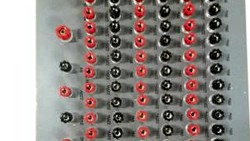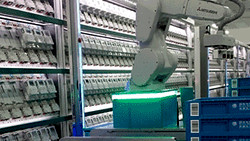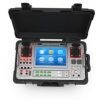When we talk about power we always need to indicate the direction and which sort of power.
We can have:
- Active power, P
Active power is expressed in watt (W). Sometimes this power is also called "real power"
This is the power you are actually consuming. - Reactive power, Q
Reactive power is expressed in volt-ampere reactive (var)
This power is stored in components, then released again back to the source through the AC cycle. Capacitors and inductors do this. - Apparent power, S
Apparent power is expressed in volt-ampere (VA)
(RMS voltage times the RMS current). A power supply must be capable to output the full apparent power delivered to a circuit, not just the active power.
Quadrant I
Quadrant I is defined as an area where both powers flow positively. Both are delivered to the consumer load. In many cases the CLOU terminology is forward. The power factor is lagging, we have inductive influence.
The IEC literature is using the term import.
In this quadrant we have Import of active power and Import of reactive power.
Quadrant II
In quadrant II, reactive power is positive and active power flows negatively. In many cases the CLOU terminology is reversed. The IEC literature is using the term export.
Quadrant III
In quadrant III, reactive and active power flow negatively (both powers are received from the customer). This is also a export condition.
Quadrant IV
In quadrant IV, reactive power flows negatively, and active power flows positively. This is a import condition.
The interactive diagram below shows the relationship between the phase angle φ, apparent-, active- and reactive power respective energy. The diagram is in accordance with clauses 12 and 14 of IEC 60375. Reference is the current vector (fixed on right-hand line, 0°). The phase angle φ between voltage V and current I is taken to be positive in the mathematical sense (counter clockwise).
Four Quadrant Simulation (IEC62053-23)
Geometric representation of active and reactive power
Note: The sine-wave diagram was changed to mathematical expression with reference on current (green). The oscilloscope view with reference on voltage was leading to misunderstanding. (24.11.2020)
Thank you for taking a look and for valuable comments.
Editor's note: This article was originally published in July 2019 and has been updated for comprehensiveness.








In quadrant III, reactive and active power flow negatively (both powers are received from the customer). as per the above statement, what would be the senorio active power flow negatively from the customer end.
Reactive power, Q stored in Capacitors and inductors, then released again back to the source through the AC cycle.
is this will be consider as a reversal power flow by the smart meter.
Thank you for your question. As long as the active power is negative, we have an export. Means, under regular conditions, the customer is feeding back power to the grid. The reactive power can under these circumstances only be in quadrant II and quadrant III. Depending on the meter type, the power consumption is recorded in the related registers (P-, Q2, Q3) or the meter is recording a tamper and takes for P the absolute value.
In any case, we have a reverse flow (export).
As KVAH is associated with KVARH ,why it is not represented in 4 quadrants?. It is only shown as export and import only but not in 4 quadrants
In this graphical representation the apparent power (S) is considered as constant. With changing of the angle you see that the active power (P) and the reactive power (Q) are in/decreasing. The four quadrant model is used for billing purpose. Each quadrant has its own register. So the utility knows whether it was import or export, inductive or capacitive. The IEC62053-23, annex C gives this simulation as diagram.
Hi!
Very informative web page, but I would like to highlight some points, perhaps you could clarify these:
Let us assume the positive current direction is towards the load. As per definition, Q = U*I*sin(theta). When theta in 0..pi, the Q is positive. The standard behind the 4 quadrant picture defines that the power factor is positive in Q1 but negative in Q2 although the reactive power sign is not changing – the load is absorbing reactive power (inductor)in both quadrants. Why they use the capacitor icon in the standard for Q2?
In Q3 and Q4, theta 180…360, the current is leading and the load is injecting reactive power (capacitor). Still, inductor sign for Q3.
I've seen that in some contexts this 4Q picture is interpreted so that the positive current direction is reversed in Q2 and Q3. That would flip the quadrants, but is not really highlighted anywhere where this 4Q picture is used.
How do you see it?
Thank you for your comment, Henrik. You have your question nice elaborated. We have a sign-change at 90° respective at 270°. So in this range you need to set your current negative (export). Your last conclusion is right, though the IEC standard doesn't mention it explicit. You can only refer to the current arrows.
Great stuff. Really helpful in visualising where the voltage and current are for each of the quadrant. I will be back to use your simulation again!
Thank you
Thank you for the kind comment.
please send me more analysis of the Four Quadrant Simulation
The general information is in the text. If you have a specific question, please let me know.
I do find the voltage and current waveform animation to be backwards from the convention I am familiar with. Any chance of creating a waveform diagram with the origin on the left? I'd love to use this as a teaching tool, but it seems to conflict with the voltage/current vs time shown in the Handbook for Electricity Metering. If that is a reference you have check out figure 4-11.
Glad you created this- very cool!
Thanks for your kind comment, Peter. I did some small modification to have the absolute time-based view. Seems that the oscilloscope view with time difference was leading to confusion. Luckily the physics don't change :)
Stay safe!
Hi,
Just for my further clarity, the four quadrant diagram above is also depending on the star point of the current transformer, may I know what is the star point for CT at primary side of the CT and secondary site of the CT in reference to P1, P2, S1 and S2.
Thanks
Thank you for your question. If you have a transformer operated meter you can easily mess up. The four quadrant diagram follows the recommended geometric representation as stated in IEC62053-23. Three-phase four wire meters for CT-connection have usually 3 instrument transformers. The star-point is build by connecting the P2's on primary side. The meter itself doesn't build a star point on secondary side. For CT-meter connections we strongly recommend a wiring check with portable test equipment like our RS350.
Hi LaoRen,
I've meter model CL730S1 on rented property shared by about 4 households.
The electricity is supplied on a pre-paid facility. This is presenting challenges in terms of defining how much each household use power and consequently how much to contribute towards the cost. It is not possible to split meters unfortunately because of regulations.
Is there a possibility to read and monitor usage via software that can track usage possibly per household? Pardon my English if my point is not clear for you, but hopefully you understand the issues of sharing one metered source in this regard.
Thank you.
Hi Stephen,
thank you for your question. A energy meter can only record the total consumption, in your case for all four households in sum. What you need is so called sub-metering. The prepaid meter still records the total units. You need to put four simple postpaid meter behind the prepaid meter. Any electrician can do this without utility approval. This meters are recording the consumption for each household individually. At the end of the month (or your billing period) you invoice the single households by reading the consumed units from each sub-meter. For four households it's easy to do it manually. For larger sub-metering installations we have special meters with an interface and a software solution for meter reading.
Hi LaoRen,
Thank you for your informative reply.
The solution has potential to help a significant number of households in my community.
I'm not tech savvy in this respect as you might have noticed. Please kindle help me further if you can:
(i)what is the cost of simple postpaid meters that you know are compatible with the meter model CL730S1 ?
(ii)are the postpaid meters mounted strictly behind the main meter or can they be mounted separately in each household?
(iii) you can send me details if you prefer direct to my email ; include details of the larger sub-metering solution as well.
Thank you once again.
Sure, Stephen.
Our regional team will contact you.
Hi,
I think I still a bit confused with how the wave is presented. In Q1, (current) lagging, the current in red should be on the right of the black voltage waveform, isn't it?
Hi Dan, thanks for your comment. Actually the x-axis is representing the continuous running time adjusted to the net-frequency. When we watch an oscilloscope screen and adjust the time domain to the net frequency we will see a static wave for voltage (black) and for current (red). As the current in Q1 is lagging, we see the current wave behind (left side) of the voltage wave. The easiest way to measure the time difference between voltage and current is to monitor the zero-crossings.
The information on the internet is often ambiguous.
It should always be specified who is used as a reference of 0 degrees: voltage or current.
For example, on this site where the reference voltage is used, the diagram is completely reversed:
https://ez.analog.com/energy-metering/f/q-a/31692/four-quadrant-energy-metering
Thank you for valuable input, Nick. Actually our diagram follows the IEC62053-23 definition, which is valid since the year 2003. The older engineers are still familiar with the representation shown in your link.